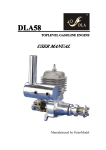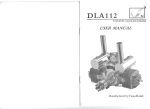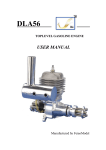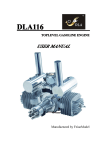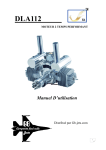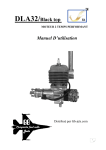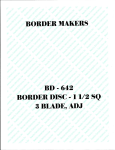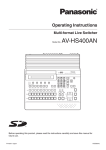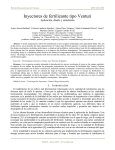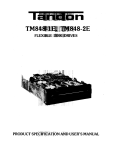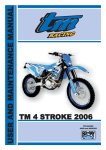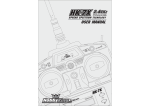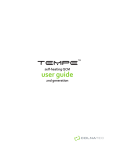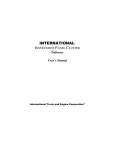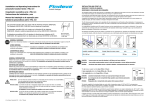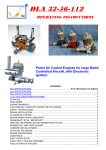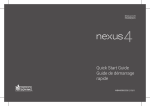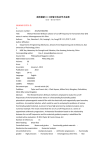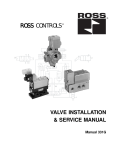Download USER MANUAL - Great Hobbies
Transcript
DLA56 DIA TOPLEVEL GASOLINE ENGINE USER MANUAL Manufactured by F eiaoModel User Manu al Thanks for purchasing DLA series engines, please read all of the instructions below before starting your engine, especially the Safety Instructions. About DLA engine Your DLA engine has been specifically designed, developed and ma nufactured from proprietary components for giant scal e modeling,it is very powerful, extremely lightweight, easy to adjust and operate, and should provide years of outstanding performance . The main components of the engine, such us the spark plug, ignition system, bearing and carb are all imported fro m world fa mous brands.The crankcases which are machined from aluminum alloy make the engines wear and da mage re sista nt. Besides excellent fit and finish, preci se bearing alignment is insured, which is critical to engine performance . The reliable auto ad vanci ng, our ignition system ins ures easy starting and excellen t performa nce . Thi s ig niti on p rovides a powerful spark, yet is fully shielded to insure protection from R/F noise. T ECHN ICAL DATA Perf ormance: 5.6HP/7500rpm Idle speed:1300rpm/min. 13.8Kg Pulling Force/1OOmeters Altitude 12Kg Pulling Force/1800meters Altitud e Propeller: 22cm*8cm , 22cm* 1Ocm Spark Plug:Special type Pa r ameter: 3 Ehaust Amount: 56cm Diameter stroke: 45mm*35mm Ratio of compression: 7.8:1 Lubrication Ratio: 30:1 (Trial Run) , 40:1-50:1 (Normal Flying Weight: Main engine -1300g , muffl er-112g, Ignition-104g Safety In str uctions before starting engines WARNING_ ! This engine is not a toy! Serious injury and lor death can occur from its misuse! READ and become familiar with this entire instruction ma nual. LEARN the engine's applications, limitations, and possible hazards. DLA is not respons ible for any loss, injury or damage resulting from the miss-use of its products. 1. Keep all spectators at least 30 feet away from the engine whil e operating the engine. 2. Do not put anything (I.e., fingers , body parts, objects, et al) into th e rotating propeller. 3. Wear proper appa rel. Do not wear loose clothing , gloves , neckties, jewelry, or neck straps, which may get caug ht in the moving propeller. 4. Always wear eye protection when starti ng the engine. 5. Inspect motor mount bolts and firewall integrity before operating the motor. 6. Turn off the motor before making any adjustments. 7. Always use the proper size and well-conditioned propell er. 8. Always use the correct length propeller bolts and make sure they are tigh t before every fligh t (screw thread-lock in g glu e is recom mended). 9. Remember to keep engine fuel in a safe place , away from any sparks, excessive heat, or anything which could ig nite the fuel. Remember that gasoline/mixture is highly flammable and must be handled with extreme caution. Do not smoke while run ning or operating the engine. 10. 0 0 not run the motor near loose material such as dirt, grave l, power cords , ro pes, san d, etc. Loose material can be drawn into the turni ng prop causing injury or damage. Engi ne in stallation 1. Make sure each engine com es with a fi rewa ll mounting plate drilled with four holes for #10 size screws. 2. A spacer is needed to keep the cooling fins away from the firewall where the firewall is larger than the engine plate. 3. In order to make sure the engine does not speed exces sively without a positive control installed ,throttle return sprin gs must be left in place. 4 . Afte r you have connected the return spring to the th rottle servo you may unhook it ( do not remove it) ,since it acts as a spacer for the butterfly. The butterfly will work loose by removing the return spring. 5. The ignition battery should be mounted externally, near the cowl, at least twelve inches from the receiver or throttle servo that connects to the receiver. 6. The carburetor needs at least 1 1/2" (38mm) o f clearance between the intake and the bottom of the cowl. If there is less th an 1 1/2", make an opening in the cowl below the carb at least as large as the carb intake diameter. 7. A long , narrow, screw driver is recommend to drill small holes in the cowl for adjusting the needle valves, since the carburetor must often be adjusted differently with the cowl on as compared to off. 8.Th ese eng ines burn between one and two ounces of fuel per minute. Therefore, a 32 ounce or larger tank is recom mended. The engines are equipped with a diaphragm pum p carburetor making tank location not critical relative to th e carb ure tors fuel entry position. Place the tank on the aircraft's ce nte r of gravity (CG). Then ai rcraft trim changes during fl ight wi ll not be necessary from a full to an empty tank. wired. Mount the ignition module usi ng the four supplied rubbe r grommets so as to create a 1/16" gap between the ignition module and the mounting surface. Without th is 1/16" gap the ignition module can overheat. Important: If the electronic ignition overheats it will malfunction (e.g., backfiring or shutting down). ,1 The propeller selection and installation Make sure the prop, spinner and prop bolts before each flight! Loose prop bolts allow prop movement which will shear the bolts. Selection: • The following props are recommended: 22cm*8cm, 22cm*10cm • Only use propeller sizes that are recommed above for your engine. • The propeller blades must be of the same length . Installation: • You must use a drill press to drill your propeller from the rear. • A drill guide is recommended , but the propeller washer can be used as a drill template. (Fix the propeller washer onto the propeller in the center-bore using a bolt and nut.) • keep your propeller balanced. Fuel: Clea n petrol 93# is strongly recommend for your DLA engines. Lubrication Ratio of trial Run is 30: 1 while normal flyi ng is 40: 1, Higher-octane fuel wi ll not generate more pow er and may cause the engine to run slower and overh eat. Note: Damage caused by fuel additi ves, su ch as nitro, over-lean carb setting s, over-ad vanced timing, and over-heating are not covered under wa rranty. Ign ition system It is im portant to understand how the ignitio n system is to be Ignition details: • The red cable is positive (+),while the black is negative(-). • Working voltage : 4 .8v-6v. • It is important to achieve the correct coordination of the sensor(s) to the magnets for fitting a new ignition. Engine starting procedure 1 j 1. Fill the tank with fresh filtered fuel. 2. Insure that your receiver and ignition batteries are charged, your receiver and transmitter are on. and that your throttle is set to low. 3. Close the choke and turn on the ignition switch. 4. Rubber stick is recommend to start the engine. 5. Begin flipping the prop through its compression stroke until the engine fires. 6. Wait for the propeller to stop spinning, turn off the ignition, and open the choke(s). 7. Switch the ignition back on and fli p the propeller ag ain until the engine starts. 8. warm up the engine for 15 or 20 seconds before advan ci ng the throttle. Carburetor Tuning and Care The use of a ta chometer is highly recommended . And, again, never adjust the needles while the engine is running! Tuning 1. Using the tachometer tune the engine for maximum power w ith the high needle (H). 2. Using the tachometer again: richen the high needle (H) until the motor runs 100-2 00 RPM less than the maximum RP M. Now you should richen slightly on the hi gh needle (H). Keep the engine run at idle for 60 seconds. Insure that the idle RPM to be constant. If the low needle (L) is too rich, it may happen that idle RPM drops until the engine stops; Lean the low needle (L) until a constant id le RPM is achieved. Check the transition with a quick throttle advance. It should sound like it is making qu ick steady power. Care: Your carb uretor screen will need to be cleaned w ith cl ean gasoline and blow off with com pressed air after every flight. Check the choke and throttle plates for tightness. Trouble Shooting Problem 1. The engine is flooded. Solution: Remove the spa rk plug; turn the engine to a position where the fuel runs out and cl ean it. Check the connections of spark plug, screws , restart the engine. If it failed to start again, please send it ba ck to After-sale service center for repair. Problem 2. The engine starts after being choked but then stops soon after. Solution: The low needle on the carburetor is probably too lean. Adjust the Low End needle until you achieve a smooth idle and a reliable transition to high throttle. Generally if the motor stutters or coughs in the mid range or wh en the throttle is advanced, the low end needle is too rich and possibly even the high end needle. Problem3. The engine runs rough and is vibrating strongly. Solution: Balance the propeller. Check the ignition tim ing. Check your plumbing for air/fuel leaks. Check your spark plug for carbon and check the spark plug gap. Check the motor mount to be sure it is rigid . Check to make sure the engine is mounted on a level surface so that crankcase is free of tension. Check the engine and propeller bolts. Problem4. The engine doesn't reach a normal RPM at full throttle. Solution: Check: A. The carbu retor settings. B. See if the propeller is too large . C. See if the engine is overheating. D. Th e ignitiontiming. E. The spark plug for defect. Verify: A. You have the correct muffler system . B. You have the correct gasoline, oil, and havemixed them with the correct ratio. DLA WARRANTY POLICY DLA engines include a limited TWO YEAR WARRANTY ON MATERIALS AND WORKMANSHIP to the ori ginal purchaser. This warranty does not cover the following: • Damage caused by improper handling, operation, modifications, or maintenance. • Damage caused by a crash. • Damage caused by using improper fuel or additives. • Damage incurred during transit to after service center. Company: Xi'an FeiaoModel Co.,Ud. Address: 506, Xitie Gongcheng Building, NO.205 Jinhuabei Road ,Xi'an, 710032, Shaanxi, China Tel: 0086-29- 68965278 Fax: 0086-29- 82197815 Email: Jessica: [email protected] Vera :[email protected] Emily:[email protected]





